Fly Tying
now browsing by category
Posted by: Warren Prior | on October 14, 2012
Flashy Profile
Flashy Profile |
|
A variation on the well known shad fly. |
|
|
|
|
Materials |
|
| Hook | 1/0 or 2/0 SS |
| Thread | Clear 3/0 (spook thread) |
| Tail | Synthetic Flash Fibre Blend white |
| Lateral Line | Pearlescent Flash |
| Wing | Synthetic Flash Fibre Blend Colour of choice |
| Head | Holographic Eyes and clear epoxy |
Tying Instructions |
|
| 1) Tie in a small bunch of the synthetic fibres 2/3 down the hook shank.
2) Tie in a few strands of Pearlescent on top. 3) Tie in the wing slightly ahead of the first bunch and form a neat taper. 4) Form an Epoxy head and stick on the eyes. 5) Turn continuously or place in a rotary drier to prevent the epoxy from running. 6) When dry trim to shape. |
|
Posted in Fly Tying, Salt Water Fly | No Comments »
Posted by: Warren Prior | on October 14, 2012
Marco’s Bass Muddler
Marco’s Bass Muddler |
|
Marco’s variation on the bass muddler. |
|
|
|
|
Materials |
|
| Hook | Size #4 long Shank |
| Thread | 3/0 Mono Colour to match |
| Overbody | Flourescent Fritz or Chenille (Crystal) |
| Wing | Deer Hair topped with Marabou and Peacock Herl |
| Collar | Spun Deer Hair |
| Head | Spun deer hair clipped to shape |
| Tail | Marabou or Bucktail (red orange chartreuse) |
Tying Instructions |
|
| 1. Start thread above barb of hook and tie in flat section of foam.
2. Tie in the tail (1/3 length of hook shank) and fritz. Wind the thread forward to about 1/2 the shank length from the eye. 3. Wind the fritz forward over the foam and tie off at the same point. 4. Stack a clump of deer hair in a stacker and tie in directly in front of the Fritz on top of the hook. The tips should extend to the bend in the hook. 5. Tie in a small bunch of marabou directly over the deer hair (colour of choice) and 4-5 Peacock Herls directly on top of that. 6. Stack a thick clump of deer hair in the stacker and spin a collar around the hook shank. 7. Repeat the above step (stacking no longer required) over and over until the front third of the shank is covered. make sure to pack the hair tightly back after each application. 8. Tie off the thread behind the hook eye and apply a drop of head cement, then shape the head with scissors or a sharp razor blade. The larger the head and collar the better the pattern will float. Note: The collar particularly the bottom provides most of the buoyancy to the fly. Clipping the bottom close to the hook shank results in a loss of buoyancy thus allowing the fly to fish sub surface. |
|
Fishing Instructions |
|
| Due to the wind resistance of the pattern at least a 5/6 weight rod is required. Cast in the direction of the bank (as close as possible) or structure, allow to settle for a few seconds then give a a few rapid short strips interspersed with pauses of a few seconds. Continue to strip until over the drop off and the repeat the sequence gradually covering all the water in front of you. The idea is to create sufficient disturbance to test the agression of the bass. By the way many a wary trout has been caught in the shallows in the early morning and late evenings on windy/stormy days. | |
Posted in Bass, Fly Tying, Fresh Water Fly | No Comments »
Posted by: admin | on October 14, 2012
Whistler Variation
Whistler Variation |
|
Primarily designed for the surf the whistler is also very effective for bass. |
|
|
|
|
Materials |
|
| Eyes | Dumbbell (Traditional Bead Chain) |
| Hook | Salt Water 1/0 to 6/0 |
| Thread | To Match 3/0 |
| Flash | Of Choice |
| Tail & Body | Schlappen Hackle Feathers |
| Head | Epoxy |
Tying Instructions |
|
| 1) Select 6 suitable hackle feathers with some marabou at the base.
2) Using figure of 8 wraps tie in the dumbbell eye’s just behind the eye of the hook. 3) Tie in some stiff squirrel tail (or Buck tail) at the bend of the hook. This prevents the tail feathers from wrapping. 4) Tie in some flash above the squirrel tail. 5) Now tie in the hackle feathers 3 on either side of the hook. (They may be tied either inward or outward) Remember to leave some marabou on the feather as this creates a lot of movement. 6) Tie in a little more flash on either side of the tail feathers. 7) Working toward the eye of the hook tie in hackle feathers at the marabou end (do not remove all the marabou in the traditional way) and wrap forward in tight turns. 8) The hackle colours can be varied to get different effects. A red hackle just before the eyes simulates bleeding gills. Finish off with a darker hackle. 9) Whip finish and apply a little epoxy or head cement to the head and eyes. 10) A small amount of super glue can be applied to he hook shank before wrapping to make the fly more durable |
|
Fly Variation |
|
|
|
|
Posted in Fly Tying, Salt Water Fly | No Comments »
Posted by: Warren Prior | on October 14, 2012
Fire Tiger Clouser
Fire Tiger Clouser |
|
A fantastic tigerfish fly. |
|
|
|
|
Materials |
|
| Hook | 1/0 SS |
| Thread | Red Or Clear 3/0 |
| Tail | 4 strands of Burnt Orange Crystal Flash |
| Body | Red Floss |
| Wing | Yellow Chartreuse and Dark Buck tail |
| Eyes | Dumbbell Eyes |
Tying Instructions |
|
| 1) Tie in the Dumbbell eyes behind the eye leaving room for the head.
2) Tie in 4 strands of crystal flash for the tail above the hook barb. 3) Dress the hook shank with a few layers of red floss and paint on a few layers of Sally Hanson’s. 4) When this has dried. Reverse the hook in the jaws and tie in a small bunch of yellow buck tail in front of the eyes. At this point a few strands of flash can be added. 5) Tie in a small bunch of Chartreuse buck tail on top of the Yellow and an even smaller bunch of a dark coloured buck tail to complete the wing. 6) Finish off the head with red or chartreuse thread and apply your favourite head cement. |
|
Posted in Fly Tying, Fresh Water Fly, Tigerfish | No Comments »
Posted by: admin | on October 14, 2012
CDC & Elk
CDC & Elk |
|
This version of the Elk Hair Caddis was developed by Hans Weilenmann. |
|
|
|
|
Materials |
|
| Hook | Dry Fly Hook #12 to #20 |
| Thread | Tan 6/0 |
| Body | CDC |
| Wing | Elk or Deer Hair (Klipspringer works well) |
Tying Instructions |
|
| 1) Tie in a spade shaped CDC feather by its tips above the barb of the hook.
2) Wrap the CDC forward around the hook shank forming the body. 3) As the CDC gets closer to the hook eye more and moor loose strands of feather appear. Stroke these back away from the hook eye and tie off just behind the eye. Leave enough room for the wing and head. 4) Stack a small clump of Elk hair and tie in the wing with a few tight turns. The wing should not extend beyond the bend of the hook. 5) Form a neat head under the Elk hair, whip finish and apply a drop of head cement. |
|
Hans Weilenmann Fishing Instruction Quote |
|
| The CDC & Elk is a very versatile pattern. While originally designed to be a dry caddis imitation, it has proven to be much more than just a ‘better’ caddis pattern! It is by far my most productive dry to use during mayfly hatches, as well as my staple search pattern during hatchless periods. Fish it as an emerger in the film. Or as a straight wet. It has proven to cover the full spectrum of dry, ‘damp’and wet. As an extremely effective 2-materials 2-minutes-to-tie this is one hard to pass up pattern. I suggest you try it! | |
Posted in Fly Tying, Fresh Water Fly, Trout | No Comments »
Posted by: Warren Prior | on October 14, 2012
Natal Minnow
Natal Minnow |
|
This fly was originally tied by Robin Fick. Recipe courtesy of Eric Pattenden. |
|
|
|
|
Materials |
|
| Hook | #4 to #10 Long Shank |
| Thread | Red |
| Head | Black Thread |
| Tail | Black Hackle |
| Body | Red Thread |
| Wings | 18 Selected Mallard Flank Feathers |
| Hackle | Red Hen |
Tying Instructions |
|
| 1) Dress the hook with thread to above hook barb.2) Tie in the tail at this point. The tail length should be 1 to 1.5 times hook shank length.
3) From the tail tie in point dress the hook with Red thread to where the head would start and tie off. (Eric says that chenille should not be used as it is too bulky and the feathers would not lie flat.) 4) Sort the feathers into 3 groups of 6 equally sized feathers. the 6 tail end feathers should be the smallest and the head end feathers the largest. These must be the full length of the body and will end just past the hook bend. Measure the feathers against the hook and strip the fibres below the tie in point. 5) Tie in the first feather about 1/4 up the shank as shown in the picture above. The tip of the feather should be just past the hook bend. The feather must be parallel to the hook bend. Tie in two more matched feathers. If the feathers have a bias it should be downward. Then repeat on the back of the fly. Note: The stripped portion of the quill should extend to the next tie in point. 6) In loose turns take the thread forward to the next tie in point trapping the stripped stems to the sides of the hook. 7) Now tie in the next set of feathers as described above with the lining up with the first set. Then in loose turns bring the thread to the final tie in point behind the head. 8) Keeping the best feathers for the outside of the fly tie in the last set as before. This set forms the full body of the fly and should extend to the tips of the first set of feathers. 9) Next tie in a red hackle just in front of the last tie in point. After 3 or 4 turns tie off and form a neat head with the black thread. The red hackle should be forced back over the body feathers as the head is tied in forming a swept back collar around the body feathers. 10) Varnish the head with you favourite head cement. 11) The fly is traditionally tied with mallard flank feathers (partridge used in the demo tying sequence) Experimenting with different types of feathers can produce interesting results. |
|
Posted in Bass, Fly Tying, Fresh Water Fly, Trout | No Comments »
Posted by: Warren Prior | on October 14, 2012
Olive Tadpole (Plattie)
Olive Tadpole (Plattie) |
|
This fly is fished with a floating line in rip currents in surf, bays or estuaries. |
|
|
|
|
Materials |
|
| Hook | Stainless Steel 2xLong #1 to 2/0 |
| Thread | Clear Mono |
| Tail | A small bunch of Calf Tail with 2 strands Flash both Sides. |
| Body | Flash or sparkle dubbing. Mylar Tube pulled over hook eye tied in above barb |
| Eyes | Bead Chain tied in on top of hook just behind eye |
Tying Instructions |
|
| 1) Dress hook2) Tie in small tuft of deer hair above hook point – helps reduce tail wrapping
3) Tie in tail of marabou 2-3 times length of hook shank above deer hair. Make one wrap of thread around the marabou only to keep it concentrated on the top of the hook shank again helps reduce tail wrapping 4) Wrap lead wire along centre half of the length of the hook shank and double back wrapping second layer to make a “ball” shape. The lead results in a dipping action on the retrieve. 5) Tie in chenille at tail and advance thread to hook eye. In process of this build up small “cone” of thread in front of the lead wire this helps the chenille transition from the lead to hook shank and prevents lead sliding forward 6) Wrap chenille forward to hook eye to form the body 7) Tie off chenille, trim and whip finish Alternatively it can be tied in black. In South Africa this fly imitates platana tadpoles that are often olive. Hence the name Plattie |
|
Fishing Instructions |
|
| Fish this fly over weed beds, along reed banks or in shallows using figure of 8 retrieve or short erratic pulls to create a darting movement. When fish are swimming circuits in the shallows allow the fly to rest on the bottom in the path of fish and give a short tug as the fish approaches.
(While fishing a lake one weekend there was a 2-3lb Brown cockfish that kept swimming a specific circuit through an area of the shallows, every time I tried to present a fly it spooked and disappeared for 15-20 minutes. Eventually I put the fly on the bottom and waited, as the fish approached I gave a 6 inch in tug this elicited a charging take and the fish was on!) |
|
Posted in Fly Tying, Fresh Water Fly, Trout | No Comments »
Posted by: admin | on October 14, 2012
Funnel Dun
Funnel Dun |
|
The Funnel Dun is a fly which Jack Blackman first introduced to us when we were still Natal Fly Dressers Society, Durban Branch – a long time ago. |
|
|
|
|
Materials |
|
| Hook | An up-eyed dry fly hook is preferred but a down-eyed dry fly hook works as well, sizes 12 to 18 |
| Thread | 6/0 – in colour to suit your chosen scheme |
| Thorax | Any dubbing material, usually darker than the abdomen. Hares Ear blend works well. |
| Hackle | Long barbuled cock hackle – colour to suit (I prefer a length of 1,5 times the hook shank) |
| Body | Soft fur dubbing of colour to suit |
| Tail | Same as for hackle – again 1,5 times the length of the shank. |
Tying Instructions |
|
| 1 : Place hook in vice, secure the thread and take it to a position just past the eye. Form a dubbing noodle with your selected material and form a neat thorax just behind the eye. The thorax should have a diameter of about a fifth to a quarter of the shank length.
2: Strip the flue off the hackle and tie the stem in at the back of the thorax, with shiny side out. Trim off the excess stem and wind the hackle backward (towards the hook bend) two to three times around the shank and tie off. Shape the hackles so that they form a funnel shape over the thorax. This is done by holding the hackle tips in the fingers of the one hand and winding the thread loosely up the barbules with the other hand and then back again. This should keep the hackle in the funnel shape. If the thread is wrapped too tightly the barbules will splay in all directions. 3: Wind the thread to a position above the barb and tie in three or four barbules for the tail. By holding the barbules down with your left hand, wind the thread to about a quarter of the way around the bend. Take the thread back to behind the hackle.Step 4: Dub body material onto the thread and form a tapered body by winding back to the tail. Tie off at the tail with a whip finish. The tie off can also be done with a yellow colour thread to imitate an egg laying insect. Happy hunting! |
|
Posted in Fly Tying, Fresh Water Fly, Trout | No Comments »
Posted by: Warren Prior | on October 14, 2012
Evil Eye
Evil Eye |
|
Tied by Graeme Neary. |
|
|
|
|
Materials |
|
| Hook | SS Size #4-#6 |
| Thread | Personal Preference |
| Tail | White Marabou + Crystal Flash |
| Body | Chartreuse Chenille |
| Eyes | Bead Chain |
Tying Instructions |
|
| 1. Dress the hook, tie in eyes a few millimeters back from the hook eye.
2. Take a good pinch of marabou for the tail approx length of the hook shank. 3. Add a few strands of either side of the tail. 4. Tie in a piece of chenille at the bend just above the barb. 5.Wind the chenille forward to eyes, run between the eyes and tie off. 6. Optional add a small marabou wing. This should extend to the hook point. Take your evil eye and head for the nearest saltwater gully. If the fish are feeding results are virtually guaranteed. |
|
Posted in Fly Tying, Salt Water Fly | No Comments »
Posted by: Warren Prior | on October 14, 2012
Hare & Copper
Hare & Copper |
|
This fly was tied for us at the July meeting by Paul Gregg. |
|
|
|
|
Materials |
|
| Hook | 3x strong nymph #16 – 12 |
| Thread | Hyperfine black or any suitable fine thread |
| Tail | Seal guard hair |
| Body | Hares Ear and Antron dubbing mix |
| Rib | Fine Copper Wire |
| Hackle | Black or Reddish Brown |
| Weight | 6 turns Siman square lead (size dependant on weighting required) |
Tying Instructions |
|
| Wrap 6 turns of square lead around shank and position leading edge 1/2 way down shank. Select bunch of seal hair, clip and remove underfur. (Keep this for dry fly dubbing).Tie in and bind down on top of the shank to beginning of lead. Clip off excess and tie down forming a smooth transition to the lead.Tie in the copper rib on the side of the hook so that it’s leading edge is secured behind the junction of lead and shank this will ensure that the first ribbing wrap crosses over the vulnerable tail tie in spot on top of the hook. This will present a smooth uniform underbody for your dubbing.
Bind in the rib to a position between the barb and point of the hook. Lightly apply tack to the thread and touch the dubbing lightly to the thread. DO NOT OVER DUB. Now roll the dubbing tightly onto the thread and wind up to junction of shank and lead. Rib through with copper wire right to behind the eye of the hook. This will give the fly extra weight at little additional bulk. Again add tack to the thread and apply dubbing. This time do not dub tightly to the thread as you need the bulk of the thorax plus the movement. I lay a foundation of zig zag dubbing before finally running the finished layer in close turns. This gives security to the underlying dubbing and prevents it from coming off the fly adding durability. I don’t bother to pick out the thorax as the lightly dubbed hares ear is very spikey besides a few fish and it is as buggy as you will want. |
|
Posted in Fly Tying, Fresh Water Fly, Trout | No Comments »

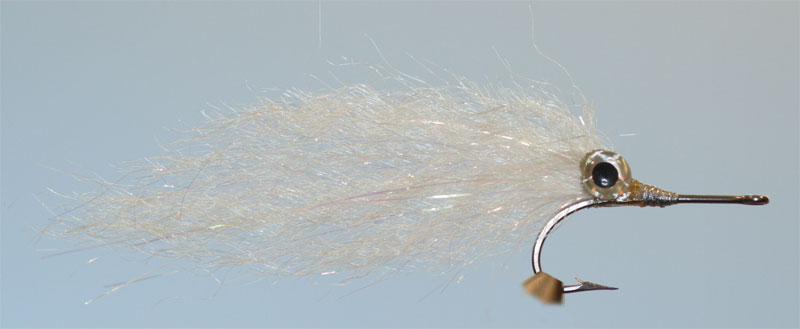
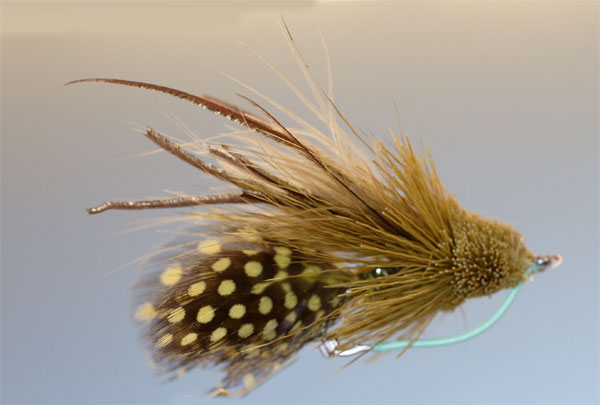


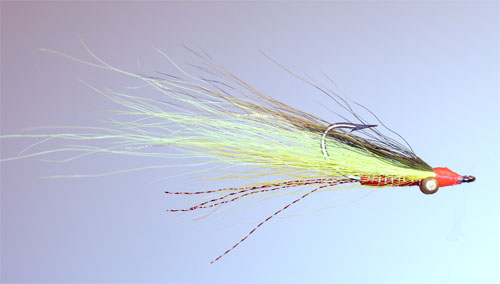
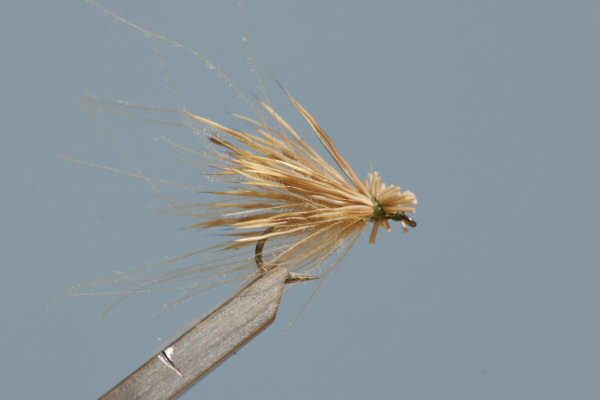
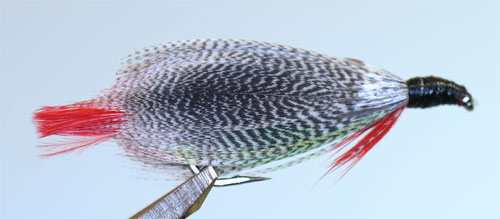
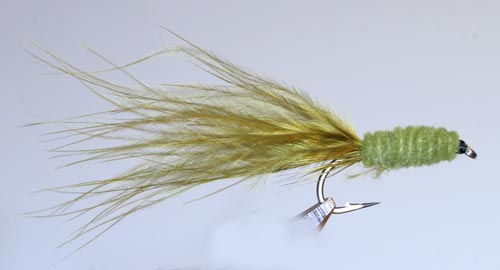
 D5 Creation
D5 Creation